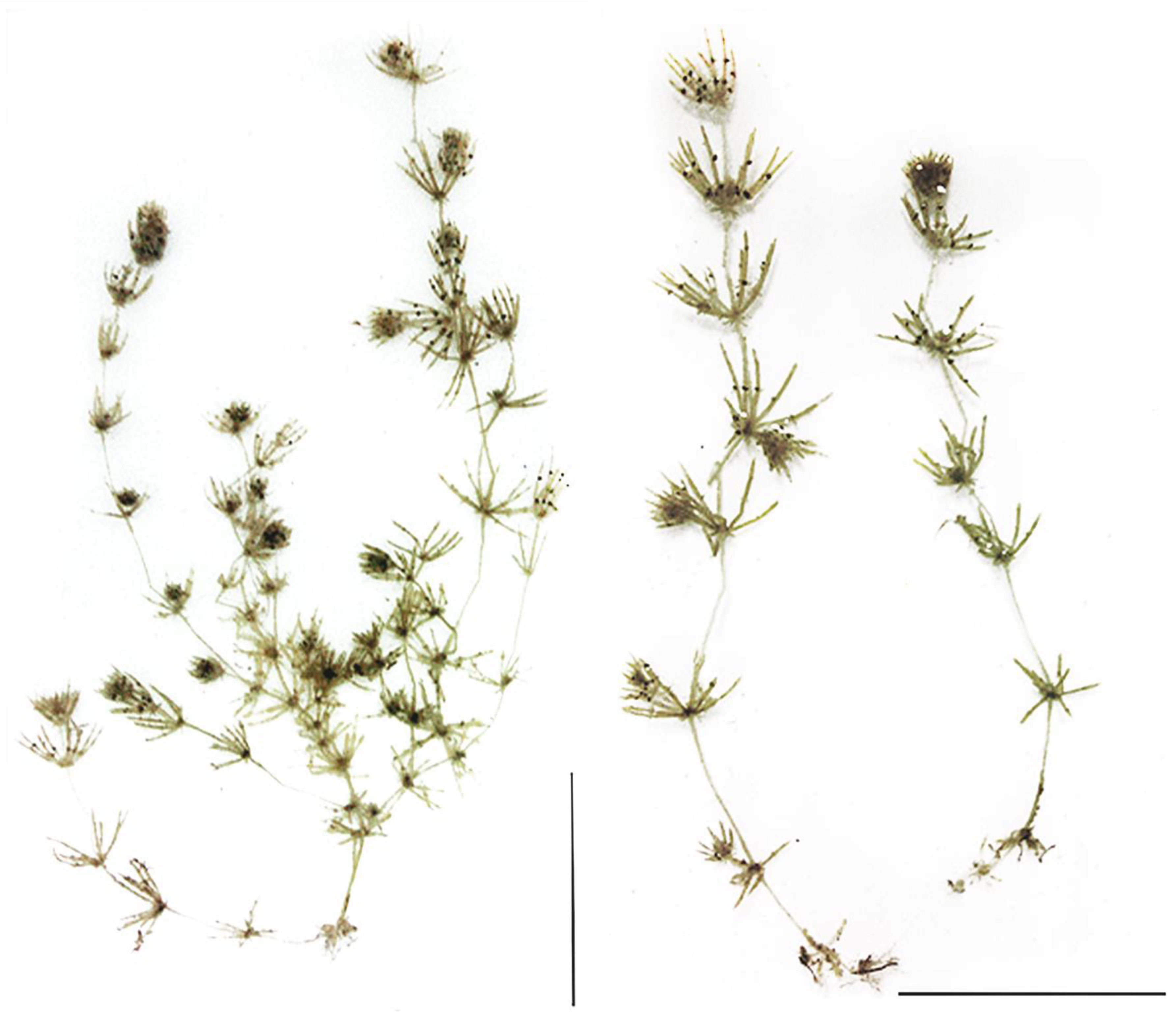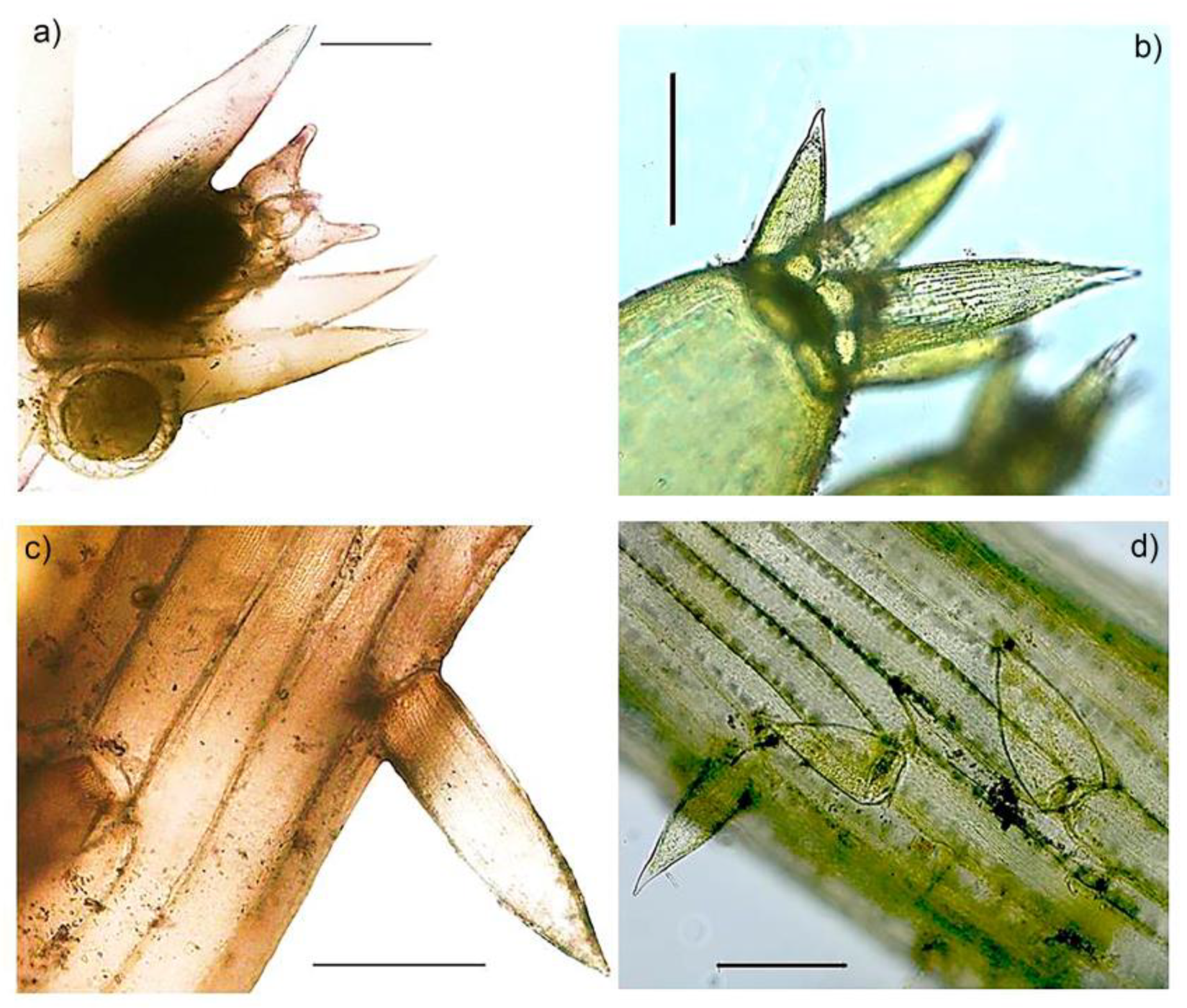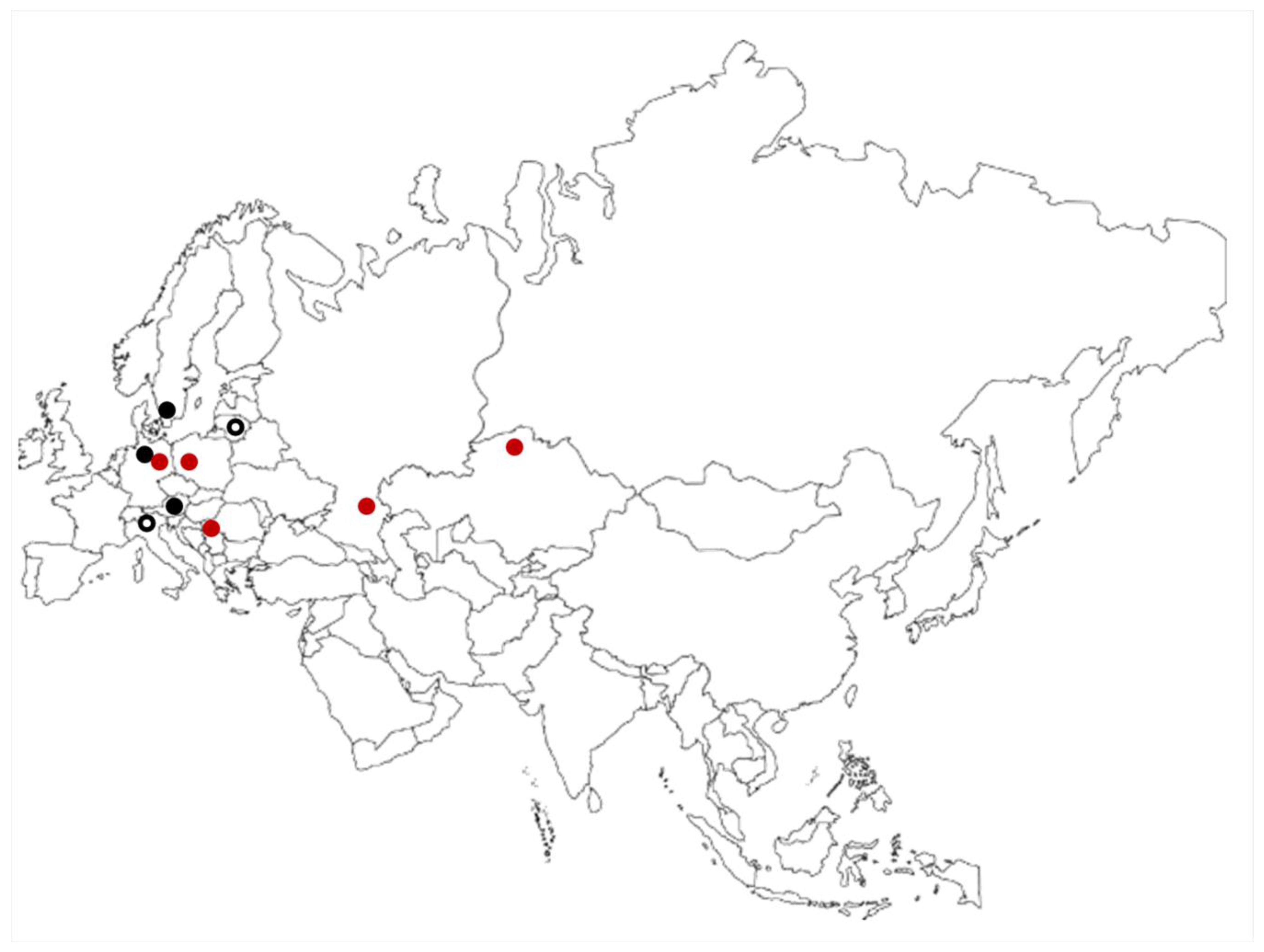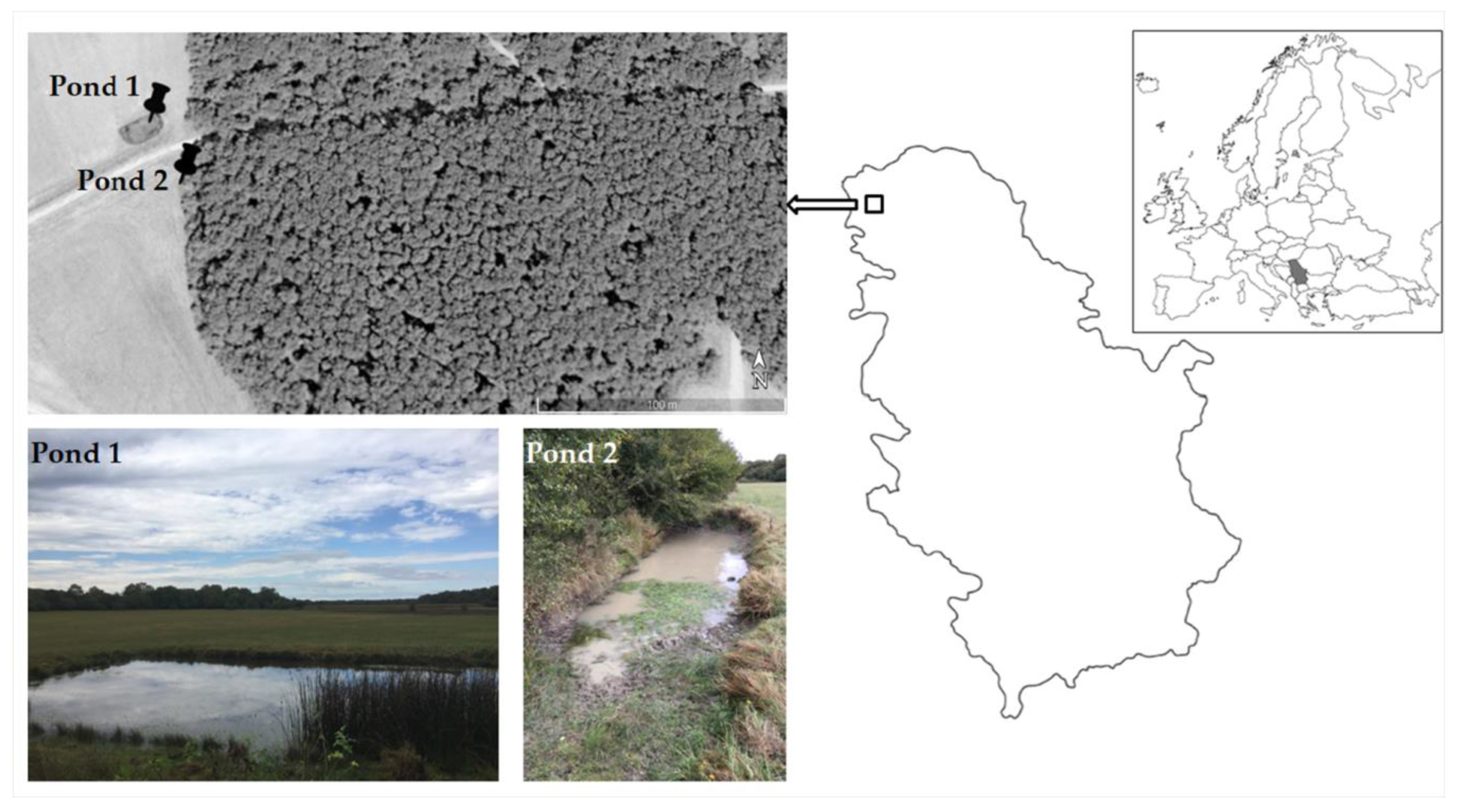The Discovery of the Rare Chara baueri (Charales, Charophyceae) in Serbia
Abstract
1. Introduction
2. Results
Description of C. Baueri from Serbia
3. Discussion
4. Materials and Methods
5. Conclusions
Author Contributions
Funding
Acknowledgments
Conflicts of Interest
References
- Pukacz, A.; Boszke, P.; Pelechaty, M.J.; Raabe, U. Comparative study of the oospore morphology of two populations of a rare species Chara baueri A. Braun in Cedynia (Poland) and Batzlow (Germany). Acta Soc. Bot. Pol. 2012, 81, 131–136. [Google Scholar] [CrossRef]
- Raabe, U. Chara baueri rediscovered in Germany—Plus additional notes on Gustav Heinrich Bauer (1794–1888) and his herbarium. Int. Res. Group Charophytes News 2009, 20, 13–15. [Google Scholar]
- Krause, W. Charales (Charophyceae) Süßwasserflora von Mitteleuropa; Gustav Fischer Verlag: Jena, Germany, 1997. [Google Scholar]
- Langangen, A.; Sviridenko, B.F. Chara baueri A. Br., a charophyte with a disjunct distribution. Cryptogam. Algol. 1995, 16, 125–132. [Google Scholar]
- Pukacz, A.; Pelechaty, M.; Raabe, U. Pierwsze stanowisko Chara baueri (Characeae) w Polsce. Fragm Florist Geobot Pol. 2009, 16, 425–429. [Google Scholar]
- Urbaniak, J.; Gąbka, M. Polish Charophytes. An Illustrated Guide to Identification; Universytet Przyrodiczy We Wroclawiu: Wroclaw, Poland, 2014; ISBN 978-83-7717-166-0. [Google Scholar]
- Klinkova, G.Y.; Zhakova, L.V. New and rare species Charales in the flora of the lower Volga region. Byull. Moskovsk. Obshch. Isp. Prir. Otd. Biol. 2014, 119, 61–66. [Google Scholar]
- Noedoost, F.; Riahi, H.; Sheidai, M.; Ahmadi, A. Distribution of Charophytes from Iran with three new records of Characeae (Charales, Chlorophyta). Cryptogam. Algol. 2015, 36, 389–405. [Google Scholar] [CrossRef]
- Schneider, S.C.; Nowak, P.; von Ammon, U.; Ballot, A. Species differentiation in the genus Chara (Charophyceae): Considerable phenotypic plasticity occurs within homogenous genetic groups. Eur. J. Phycol. 2016, 51, 282–293. [Google Scholar] [CrossRef]
- Reichenbach, H.G.L. Dr. Joh. Christ. Mössler’s Handbuch der Gewächskunde, Enthaltend eine Flora von Deutschland mit Hinzufügung der Wichtigsten Ausländischen Cultur-Pflanzen, 2nd ed.; Johann Friedrich Hammerich: Altona, Germany, 1829; Volume 3, pp. 1592–1601. [Google Scholar]
- Braun, A. Uebersicht der genauer bekannten Chara-Arten. Flora Allg. Bot. Ztg. 1835, 18, 49–73. [Google Scholar]
- Braun, A.; Nordstedt, C.F.O. Fragmente einer Monographie der Characeen; Königlichen Akademie der Wissenschaften: Berlin, Germany, 1882; pp. 1–211. [Google Scholar]
- Ganterer, U. Die Bisher Bekannten Österreichischen Charen: Vom Morphologischen Standpunkte Bearbeitet; Carl Haas’schen Verlag: Vienna, Austria, 1847. [Google Scholar]
- Migula, W. Die Characeen Deutschlands, Oesterreichs und der Schweiz: Unter Berücksichtigung aller Arten Europas; E. Kummer: Leipzig, Germany, 1897. [Google Scholar]
- Hutorowicz, A. Morphological variability of oospores of Chara baueri A. Braun [Characeae]. Acta Soc. Bot. Pol. 2007, 76, 235–237. [Google Scholar] [CrossRef][Green Version]
- Wood, R.D.; Imahori, K. A Revision of the Characeae. First Part:Monograph of the Characeae; J. Cramer Verlag: Weinheim, Germany, 1965. [Google Scholar]
- Гoллербах, М.М.; Красавина, Л.К. Харoвые Вoдoрoсли. Определитель Преснoвoдных Вoдoрoслей СССР; Nauka: Leningrad, Russia, 1983. [Google Scholar]
- Google Earth. Available online: https://earth.google.com/web/search/Sankt+Andr%c3%a4,+Austria/@45.81280243,18.96052335,83.72340015a,114.48633148d,35y,0h,0t,0r/data=CigiJgokCQAz16vOpUdAEdpVE1pBRUdAGQnvaQoHsjBAIfzZ_8Vy3CxA (accessed on 26 October 2020).
- Becker, R. Gefährdung und Schutz von Characeen. In Armleuchteralgen. Die Characeen Deutschlands; Deutschlands, A.C., Ed.; Springer: Heidelberg, Germany, 2016; pp. 149–191. ISBN 978-3-662-47796-0. [Google Scholar]
- Doege, A.; van de Weyer, K.; Becker, R.; Schubert, H. Bioindikation mit Characeen. In Armleuchteralgen. Die Characeen Deutschlands; Deutschlands, A.C., Ed.; Springer: Heidelberg, Germany, 2016; pp. 149–191. ISBN 978-3-662-47796-0. [Google Scholar]
- Gregor, T. Chara baueri. In Armleuchteralgen. Die Characeen Deutschlands; Deutschlands, A.C., Ed.; Springer: Heidelberg, Germany, 2016; pp. 247–248. ISBN 978-3-662-47796-0. [Google Scholar]
- Trbojević, I.; Marković, A.; Blaženčić, J.; Subakov Simić, G.; Nowak, P.; Ballot, A.; Schneider, S. Genetic and morphological variation in Chara contraria and a taxon morphologically resembling Chara connivens. Bot. Lett. 2020, 167, 187–200. [Google Scholar] [CrossRef]
- Simić, D.; Puzović, S. Ptice Srbije i Područja od Međunarodnog Značaja; Liga za ornitološku akciju Srbije: Belgrade, Serbia, 2008; ISBN 978-86-911303-0-5. [Google Scholar]
- BirdLife International (2020) Species factsheet: Anser Anser. Available online: http://datazone.birdlife.org/species/factsheet/greylag-goose-anser-anser/distribution (accessed on 4 September 2020).
- Dick, G.; Baccetti, N.; Boukhalfa, D.; Darolova, A.; Faragó, S.; Hudec, K.; Leito, A.; Markkola, J.; Witkowski, J. Graylag Goose Anser anser: Central Europe/North Africa. In Goose Populations of the Western Palearctic. A Review of Status and Distribution; Madsen, J., Cracknell, G., Fux, T., Eds.; Wetlands International Publication: Wageningen, The Netherlands; National Environmental Research Institute: Rønde, Denmark, 1999; pp. 202–213. ISBN 87-7772-437-2. [Google Scholar]
- Wood, R.D.; Imahori, K. A Revision of the Characeae. Second Part: Iconograph of the Characeae; J. Cramer Verlag: Weinheim, Germany, 1964. [Google Scholar]




| T | O2 | O2 | pH | Cond | °dH | Ca2+ | Mg2+ | NO2- | NO3- | NH4+ | TN | OP | TP | |
|---|---|---|---|---|---|---|---|---|---|---|---|---|---|---|
| °C | mg/L | % | µS/cm | mg/L | mg/L | mg/L | mg/L | mg/L | mg/L | mg/L | mg/L | |||
| POND 1 | ||||||||||||||
| May 2018 | 20.5 | 9.05 | 102 | 8.23 | 325 | - | - | - | - | - | - | - | - | - |
| June 2018 | 22 | 4.42 | 50.5 | 8 | 300 | - | - | - | - | - | - | - | - | - |
| July 2018 | 30.7 | 15.45 | 190 | 9.35 | 338 | 1.1 | 3.7 | 2.7 | 0.021 | <0.5 | 0.24 | 2.5 | <0.020 | 0.028 |
| August 2018 | 31 | 12 | 162 | 8.76 | 379 | 2.6 | 8.8 | 5.7 | <0.020 | <0.5 | 0.23 | 1.9 | <0.020 | 0.026 |
| September 2018 | 14.5 | 9.94 | 101.2 | 8.68 | 346 | 6.3 | 30.2 | 9.1 | 0.027 | <0.5 | <0.05 | 2.9 | <0.020 | 0.031 |
| May 2019 | 18 | 15 | 152.6 | 9.61 | 328 | 5.2 | 12 | 15 | <0.005 | <0.5 | 2.2 | 1.2 | <0.010 | 0.24 |
| June 2019 | 29.15 | 11.9 | 157.5 | 9.13 | 344 | 3.7 | 11.6 | 9 | <0.005 | <0.5 | 0.45 | 1.5 | <0.010 | 0.07 |
| July 2019 | 28.3 | 2.57 | 32.4 | 8.13 | 445 | 6.1 | 23.2 | 12.4 | <0.005 | <0.5 | 0.54 | 1.9 | <0.010 | 0.07 |
| POND 2 | ||||||||||||||
| May 2018 | - | - | - | - | - | - | - | - | - | - | - | - | - | - |
| June 2018 | 21 | 2.21 | 25.4 | 7.56 | 275 | - | - | - | - | - | - | - | - | - |
| July 2018 | 28.1 | 7.5 | 96.5 | 8.12 | 342 | 6.1 | 31.2 | 7.5 | 0.043 | <0.5 | 0.21 | 1.7 | <0.020 | 0.029 |
| August 2018 | 26.1 | 6.24 | 77.1 | 8.44 | 435 | 4.4 | 21.8 | 5.9 | <0.020 | <0.5 | 0.18 | 3 | <0.020 | 0.046 |
| September 2018 | 15 | 12 | 120 | 9.08 | 355 | 6.7 | 33.8 | 8.4 | 0.08 | 0.91 | 0.79 | 5.3 | <0.020 | 0.04 |
| May 2019 | 15.5 | 13.7 | 135.2 | 9.18 | 352 | - | - | - | - | - | - | - | - | - |
| June 2019 | 28 | 3.63 | 43.6 | 7.96 | 354 | - | - | - | - | - | - | - | - | - |
| July 2019 | 25.6 | 2.42 | 28.4 | 8.13 | 416 | - | - | - | - | - | - | - | - | - |
| Literature Source | Reichenbach, 1829 [10] | Braun, 1835 [11] Braun and Nordstedt, 1882 [12] | Ganterer, 1847 [13] | Migula, 1897 [14] | Langangen and Sviridenko, 1995 [4] | Hutorowicz, 2007 [15] | Pukacz, 2012 [1] | Urbaniak and Gąbka, 2014 [6] | Specimens from Serbia |
|---|---|---|---|---|---|---|---|---|---|
| Note | Specimen from Kazakhstan (1994)/ Specimen from Sweden (1849), herbarium specimen examined in dry condition | Oospores from specimens from Kazakhstan [4] | Oospores from specimens from Cedynia, Western Poland (August 2008)/ Oospores from specimens from near Batzlow, Germany (2006) | ||||||
| Habitus description | Nice green color, turning black towards the bottom. Stiff stature, almost cartilaginous, ‘’shining’’ similarly to Ceratophyllum. | Hard to differentiate from Ch. coronata (Chara braunii) without the loupe | Richly branched, bushy habitus, mostly light green in color | Habitus is not easy to distinguish from Ch. coronata (Chara braunii), all parts are proportionally thicker. Light yellow-green or green, rarely brownish-green. | -/- | - | - | Rather small plants, richly branched, yellow green to light green, strongly resembling C.braunii | Light green to yellowish green. Resembling C. braunii, but branchlets more rounded, plump and voluminous—like succulent. |
| Axes | |||||||||
| 1. Incrustation | - | Not incrusted | - | Incrustation is abundant | Not incrusted/ slightly incrusted | - | - | Slightly incrusted | Very slightly incrusted |
| 2. Diameter | More than 1.0975 mm (more than ½ Linie, 1 Linie = 2.195 mm) | Up to 1 mm | Up to 0.57 (0.65 in Figure 2 caption) mm/0.93 mm | 0.6–2.1 mm | 0.55–0.95 mm | ||||
| Cortex | - | Finely striped cortex | In the uppermost internodes, or throughout the stem more or less clearly and finely striped, and covered with scattered spines | Triplostichous, isostichous | 2–3 corticate, isostichous, young internodes mostly 2 corticate/ Mostly 2 corticate, isostichous (hard to determine in dry material) | - | - | Triplostichous, in some parts irregular | Triplostichous, isostichous cortex developed throughout the stem, in some parts irregular |
| Spine cells | |||||||||
| 1. Description | - | Fine, spiked | - | Solitary, up to ½ of axes diameter, acuminate–spiky, especially in young segments | Solitary, acute, to 1 x stem diameter, commonly shorter, many on young internodes/ Solitary, acute, many in young internodes, only few in the lower parts of stem | - | - | Solitary, common, acuminate, not exceeding axes diameter | Large, solitary, acuminate, more numerous in the upper section of axes |
| Branchlets | |||||||||
| 1. Number in a whorl and description | - | Ecorticated | Ecorticated | 8–9 | 8–9, ecorticated/ 7–8, ecorticated | - | - | 7 | 8–11, ecorticated |
| Oogonia | |||||||||
| 1. Number in node | Usually geminate, rarely 1 or 3 | - | Single, geminate or 3, ovoid | - | - | - | - | - | 1, mostly 2, sometimes even 3 |
| 2. Dimensions (length × width) | - | 700–880 µm × 380–480 µm | - | 650 × 500 µm | 1000 µm/ 600 µm × 250 µm (immature) | - | - | 585–950 µm × 365–610 µm | 580–710 (775) µm × 370–450 µm |
| 3. Number of convolutions | 8–10 | 10–11 | Mostly 10 | 8–10 | - | - | - | - | 9–10 |
| 4. Coronula width × height | - | 140–200 µm × 220–250 µm | 150–200 µm | - | - | - | - | (120) 170–260 (275) µm × (150) 200–330 (350) µm | |
| Oospore | |||||||||
| 1. Color | - | - | - | Black | -/Black | Light brown to black/- | Dark brown or black/- | Black/dark brown | Black |
| 2. Dimensions (length × width) | - | 500–560 µm × 310–350 µm | - | 500–550 µm × 280–340 µm | -/600 µm | 436–574 µm × 281–340 µm | 400–667 µm × 183–300 µm/417–550 µm × 216–300 µm | 465–740 µm × 280–340 µm | 475–620 µm × 230–350 µm |
| 3. Ridges description | - | - | - | Irregular, blunt/sharp edges | - | Unpronounced in young and prominent in mature oospores | Prominent ridges/- | - | Oval, blunt |
| 4. Ridges number | - | - | - | 8 | - | 8–11 | 8–11 (most often 9)/8–11 | - | 8–10 (11) |
| 5. Fossa | - | - | - | - | - | - | - | - | 50–70 µm |
| 6. Membrane coloration | - | - | - | - | - | - | - | - | Light brown |
| 7. Membrane structure | - | - | - | - | - | Either smooth or finely granulated | - | - | Finely granulated |
| Antheridia | |||||||||
| Diameter and description | In pairs or individual, brick red color | 280–370 µm | Individual or in pairs, beneath the oogonia | 250–300 µm | -/200 µm | - | - | 250–330 µm, below oogonia | 250–300 µm, below oogonia, individual, brick red color |
| O2 (mg/L) | Hardness (°dH) | pH | Conductivity (µS/cm) | Mg2+ (mg/L) | Ca2+ (mg/L) | TP (mg/L) | PO4− (mg/L) | TN (mg/L) | NO2− (mg/L) | NO3− (mg/L) | NH4+ (mg/L) | |
|---|---|---|---|---|---|---|---|---|---|---|---|---|
| Pukacz et al., 2012 [1] | ||||||||||||
| Cediniya (Poland) | 6.14 | 12.9 | 8.01 | 611 | 14.9 | 71.7 | 1.04 | 0.63 | 3.89 | - | 0.47 | 1.31 |
| Batzlow (Germany) | 3.25 | 13.2 | 7.92 | 632 | 16.3 | 67.6 | 1.12 | 0.71 | 5.15 | 0.02 | 0.68 | 1.45 |
| This study | ||||||||||||
| Pond 1 | 10.04 | 4.17 | 8.7 | 350.6 | 8.98 | 14.92 | 0.08 | <0.015 | 1.98 | 0.02 | <0.5 | 0.73 |
| Pond 2 | 6.8 | 5.73 | 8.3 | 361.3 | 7.27 | 28.93 | 0.04 | <0.02 | 3.33 | 0.06 | 0.91 | 0.39 |
Publisher’s Note: MDPI stays neutral with regard to jurisdictional claims in published maps and institutional affiliations. |
© 2020 by the authors. Licensee MDPI, Basel, Switzerland. This article is an open access article distributed under the terms and conditions of the Creative Commons Attribution (CC BY) license (http://creativecommons.org/licenses/by/4.0/).
Share and Cite
Trbojević, I.; Milovanović, V.; Subakov Simić, G. The Discovery of the Rare Chara baueri (Charales, Charophyceae) in Serbia. Plants 2020, 9, 1606. https://doi.org/10.3390/plants9111606
Trbojević I, Milovanović V, Subakov Simić G. The Discovery of the Rare Chara baueri (Charales, Charophyceae) in Serbia. Plants. 2020; 9(11):1606. https://doi.org/10.3390/plants9111606
Chicago/Turabian StyleTrbojević, Ivana, Vanja Milovanović, and Gordana Subakov Simić. 2020. "The Discovery of the Rare Chara baueri (Charales, Charophyceae) in Serbia" Plants 9, no. 11: 1606. https://doi.org/10.3390/plants9111606
APA StyleTrbojević, I., Milovanović, V., & Subakov Simić, G. (2020). The Discovery of the Rare Chara baueri (Charales, Charophyceae) in Serbia. Plants, 9(11), 1606. https://doi.org/10.3390/plants9111606







